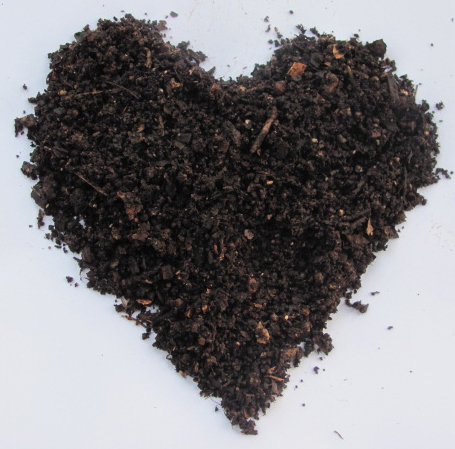
As demonstrated in any playground sandbox, the simple process of scooping up earth and placing it in a pile can provide a child with immense satisfaction. The compost pile can be the adult version of that fundamental experience. Composting is a free and easy way to recycle your kitchen and yard wastes resulting in a dark, crumbly substance that is excellent for adding to houseplants or enriching garden soil. If you are not already composting, listed below is just enough information to initiate the process. As Ghandi once said, “To forget how to dig the earth and tend the soil is to forget ourselves.”
Start by finding a convenient spot on the ground; ideally, this spot will have at least partial shade. Avoid putting the pile against anything you do not want composted such as buildings and trees. To speed up the process – composting requires the right balance of carbon to nitrogen (aka brown material such as sawdust or fall leaves to green material such as grass clippings and vegetable scraps.) You will want the pile to consist of mainly brown materials. Brown materials are readily available in the fall; but if you are starting in the summer, you may want to make sure you have some on hand. A good way to get started is to accumulate one kitchen size trash bag full of brown materials and then add one ice cream bucket of green materials. Too much brown will slow down the decomposition and too much green will make for a slimy, smelly pile that does not heat up.
The “just throw it in a pile” method works fine but does require a great deal of patience to see the end result. Without any help from you, the compost pile may take two years or more to finish. But with help, the pile could be finished in as little as three months. Helping the compost pile means keeping it moist, breaking it up, and turning it. Many of the bacteria that break down your compost need air to survive. A week or two after the pile is started these bacteria will start to die as they begin using all the available oxygen.
This drop in the amount of bacteria will result in the compost pile cooling off. When this happens, it is time to turn the pile to get more air into it and break up the plant materials. If you have allowed the pile to dry out it is a good idea to wet it before turning it to avoid breathing in the dust. Keep in mind that you need to turn the compost pile frequently so do not let it become too large. By keeping the pile no higher than 3 feet and no wider than 3 feet, turning it should not be much of a chore.
Composting is garden alchemy; taking what is otherwise rubbish needlessly piling up in landfills and turning it into an elixir of life for your garden and houseplants. The more work you put into it, the faster this transformation will take place. Even in the laziest compost pile, you may remember what it is like to find a bit of joy in a pile of earth.
Angela Lundmark enjoys gardening outdoors and indoors and freelance writer.
Related Articles & Free Email Newsletter
Bacteria are Great for Compost Tea
Five Ways to Make Help Nature Make Topsoil




Comment here